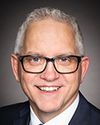I'm going to call this meeting to order.
Welcome to meeting number 13 of the House of Commons Standing Committee on Indigenous and Northern Affairs. I would like to start by acknowledging that I am joining you today from the traditional territory of the Haudenosaunee, Anishinabe and Chonnonton nations.
Pursuant to the order of reference of April 20, 2020, the committee is meeting for the purpose of receiving evidence concerning matters related to the government’s response to the COVID-19 pandemic. Today’s meeting is taking place by video conference, and the proceedings will be made available via the House of Commons website. During this meeting, the webcast will always show the person speaking, rather than the entirety of the committee.
In order to facilitate the work of our interpreters and ensure an orderly meeting, I would like to outline a few rules to follow.
Interpretation in this video conference will work very much like in a regular committee meeting. You have the choice, at the bottom of your screen, of the floor, English or French icon. In order to resolve the sound issues raised in recent virtual committee meetings and ensure clear audio transmission, we ask those who wish to speak during the meeting to set their interpretation language as follows: If speaking in English, please ensure you are on the English channel, and if speaking in French, please ensure you are on the French channel. As you are speaking, if you plan to alternate from one language to the other, you will also need to switch the interpretation channel so it aligns with the language you are speaking. You may want to allow for a short pause when switching languages.
Before speaking, please wait until I recognize you by name. When you are ready to speak, you can either click on the microphone icon to activate your mike, or you can hold down the space bar while you are speaking. When you release the bar, your microphone will mute, just like a walkie-talkie.
This is a reminder that all comments by members and witnesses should be addressed through the chair. Should members need to request the floor outside of their designated time for questions, they should activate their microphone and state that they have a point of order. If a member wishes to intervene on a point of order that has been raised by another member, they should use the “Raise hand” function. This will signal to the chair your interest in speaking. To do so, click on “Participants”, which is to the left at the bottom of the screen, next to the interpretation icon. When the list pops up, you will see next to your name that you can click “Raise hand”.
When speaking, please speak slowly and clearly. When you are not speaking, your mike should be on mute. The use of headsets is strongly encouraged. If you have earbuds with a microphone, please hold the microphone near your mouth when you are speaking to boost the sound quality for our interpreters.
Should any technical challenges arise, for example in relation to interpretation or if you are accidentally disconnected, please advise the chair or the clerk immediately, and the technical team will work [Technical difficulty—Editor]. Please note that we may need to suspend during these times as we need to ensure all members are able to participate fully.
Before we get started, can everyone click on their screen, in the top right-hand corner, and ensure they are on gallery view? With this view, you should be able to see all of the participants in a grid view. It will ensure that all video participants can see one another.
During this meeting, we will follow the same rules that usually apply to opening statements and the rounds for questioning of witnesses during our regular meetings. Each witness will have up to five minutes for an opening statement, followed by the usual rounds of questions from members. I'll be fairly tough on the time limits so we can ensure that our round of questioning goes to its fullest extent and no one is missed.
Now, before we welcome our witnesses, I would like to draw members' attention to a procedural issue arising from the committee’s last meeting. As you'll recall, at the end of the meeting on Friday, May 29, Mr. Schmale moved a motion to invite the Wet’suwet’en elected chiefs to appear before the committee with regard to its study of the government’s response to the COVID-19 pandemic.
The motion was defeated by a show of hands. Pursuant to the order of the House from May 26, 2020, while meeting by video conference, motions should be decided by way of a recorded vote. As the matter was not decided in accordance with the order from the House, I would like to declare now the results of the motion null and void and put the decision before the committee once again, to be decided by way of a recorded vote.
The question is on the motion moved by Jamie Schmale on Friday, May 29:
That, with respect to the Committee’s study of the government’s response to the COVID-19 Pandemic, the committee invite the Wet’suwet’en elected Chiefs, specifically, Chief Rosemarie Skin, Skin Tyee Nation, Chief Dan George, Burns Lake Band (Ts’il Kaz Koh) First Nation, Chief Maureen Luggi, Wet’suwet’en First Nation, Chief Patricia Prince, Nee Tahi Buhn Indian Band, Hereditary Chief Herb Naziel, Hereditary Chief, Gary Naziel, Hereditary Chief Theresa Tait-Day, and others as required to provide testimony on how the COVID-19 pandemic has affected their ability to enter into open and transparent negotiations regarding land rights and title with the federal government.
We will now proceed to the taking of the recorded division.
(Motion negatived: nays 7; yeas 4)
In light of that, I declare the motion defeated.
It's time to welcome the witnesses on our panel today: from First Nations Finance Authority, Ernie Daniels, president and chief executive officer, and Steve Berna, chief operating officer; from Metis Settlements General Council, Herbert Wayne Lehr, president; and from Cameco Corporation, Jonathan Huntington, vice-president of sustainability and stakeholder relations, and Dale Austin, manager, federal and provincial government relations.
Mr. Daniels, you are up first. You have five minutes to present testimony. Please go ahead.




